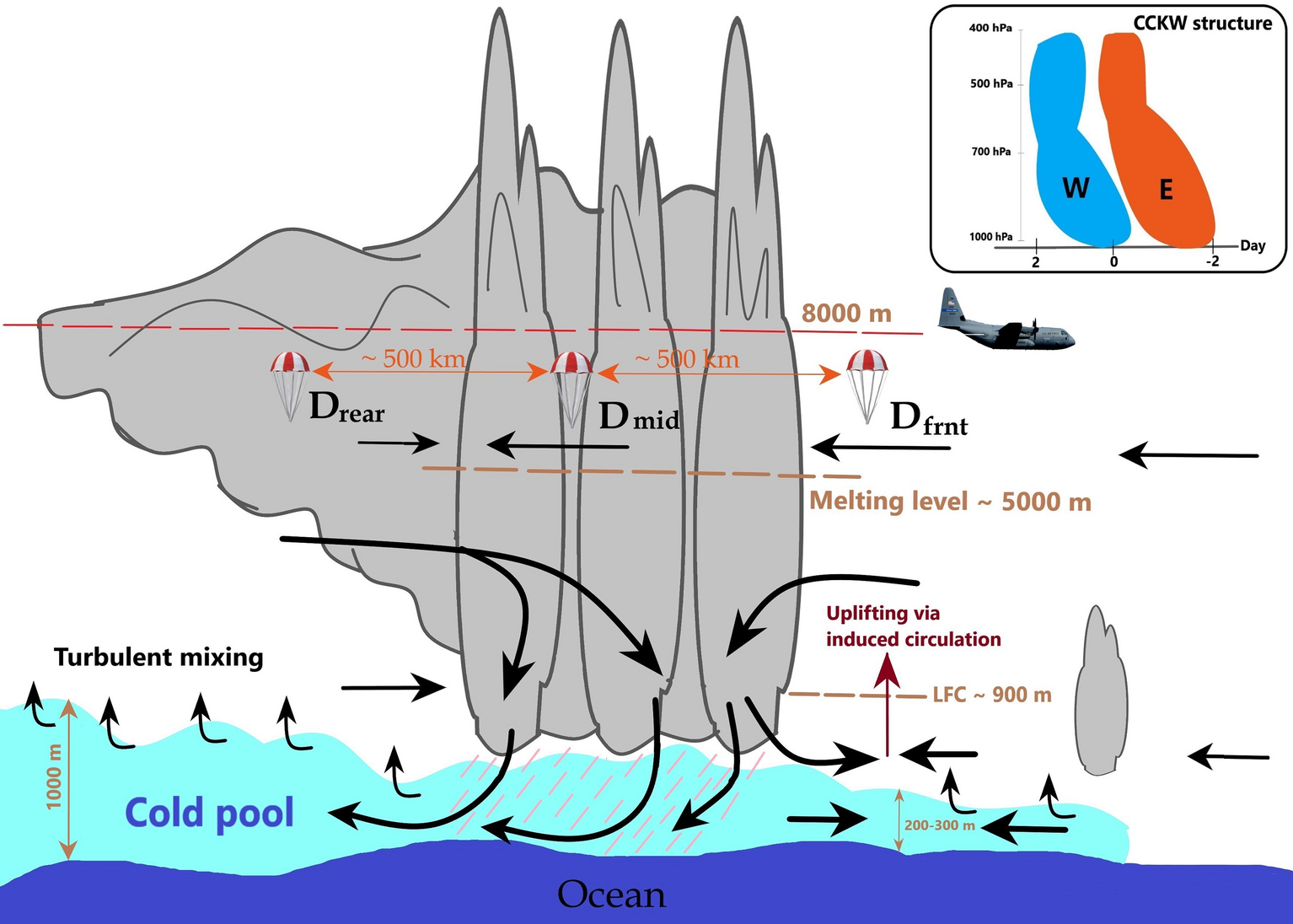
Picture of R/V Thompson in the Bay of Bengal. (Picture: San Nguyen)
In the pursuit of advancing our understanding of the monsoons and air-sea interaction, Tandon Lab members recently participated in a remarkable 45-day field campaign (following the pilot cruise in 2023) as part of the EKAMSAT (Enhancing Knowledge of the Arabian Sea Marine Environment through Science and Advanced Training) program on R/V Thomas G Thompson. This collaborative effort involved scientists from the USA and India, with the U.S. team funded by the U.S. Office of Naval Research and the Indian team supported by the Ministry of Earth Sciences (MoES). NASA-funded scientists also joined the research team to examine the ocean ecosystem. Originally planned for the Arabian Sea, the fieldwork had to pivot to the Bay of Bengal due to geopolitical tensions in the region . Around 60 scientists from various prestigious institutions, including the University of Washington, Scripps Institution of Oceanography, Woods Hole Oceanographic Institution, Columbia University, NOAA Center for Weather and Climate Prediction, University of Alaska-Fairbanks were part of this fieldwork. Indian institutions such as INCOIS, NIOT, NCMRWF, SAC-ISRO, and IITM-Pune also participated in the effort.
Objectives and Operations
The campaign aimed to study the atmospheric and oceanic boundary layer during the formation and destruction of a mini-warm pool in the Bay of Bengal. A mini-warm pool is a localized region of warm water that promotes water vapor convection, significantly impacting large-scale weather systems, such as the propagation of the monsoon. The team sought to observe the spatial extent of the mini-warm pool, the dynamics associated within it as this can affect regional weather patterns. The destruction of mini-warm pool or mixing of the warm water by the monsoon winds was also the focus of this study, amidst cyclones.
The fieldwork was split into two distinct legs. The first leg, from April 26 to May 14, 2024, focused on surveying the Bay of Bengal basin using an underway CTD (uCTD) to capture the spatial and vertical extent of the mini-warm pool across the Bay of Bengal basin. The team sailed from Chennai, India. Prof. Amit Tandon was one of the senior scientists on the first leg of the cruise, with Dr. Craig Lee from the University of Washington serving as the chief scientist. This phase also involved deploying autonomous instruments like wave-gliders, sea-gliders, and floats to measure various oceanographic parameters across a small part of the region.

EKAMSAT Leg-1 Science team (top). Prof Amit Tandon with AB Brian (bottom).
The second leg, from May 15 to June 15, 2024, led by Dr. Leah Johnson, focused on more detailed measurements using shipboard instruments like the FastCTD, Epsi, and T-Pads—cutting-edge devices developed by the Multi-scale Ocean Dynamics group at Scripps Institution of Oceanography. These instruments collected fine-scale ocean profiles. The configuration of the remote and shipboard instruments was aimed as to close the heat budget for the ocean and to understand the small-scale variabilities within the mini-warm pool’s dynamics. Radiosondes were also launched to collect atmospheric data, providing a more comprehensive view of how atmosphere evolved during the onset of the monsoon.

EKAMSAT Leg-2 Science team (Picture: San Nguyen)
Tandon Lab’s Contributions

Debarshi and Sid braving heavy rain and rough sea conditions during their deploying/monitoring instruments (Picture: San Nguyen and Kerstin Bergentz)
Sid Kerhalkar (PhD candidate at SMAST) and Debarshi Sarkar (PhD student in EAS program) from Tandon Lab braved challenging conditions—battling monsoon rains, tropical cyclones and high waves—while participating in watches to monitor, deploy, and recover shipboard instruments. Sid led the analysis of wave parameters during this fieldwork, while Debarshi contributed to the air-sea interaction analysis. In addition to their technical contributions, both were also involved in learning to launch radiosondes to capture atmospheric conditions during key periods of the monsoon.

Sid deploying the Radiosonde (Picture: Devmi Gamage)
Life at Sea
Beyond the scientific work, which bonded the team, life aboard the R/V Thomas G. Thompson was a unique experience. Daily science meetings provided an opportunity for the team to share findings from their earlier studies, discuss the upcoming weather and discuss new, exciting data collected during the cruise. Sid and Debarshi, along with their scientific contributions, added some flavor to ship life—quite literally! They were the part of the Indian-origin members of science team who volunteered to give the ship’s chefs a break for a meal, whipping up an Indian feast for the entire science team and crew (~60 people), which turned out to be a memorable event.

Sid (top left) and Debarshi (bottom left) busy cooking the Indian meal with the Indian team. Science team (right) seems happy with the meal serving. (Picture: San Nguyen and Sid Kerhalkar)
Sid also continued his hobby of video documentation, capturing the essence of life at sea and the exciting moments of the cruise—just as he had done in the previous year’s pilot expedition .

Underwater picture of Epsi profiler (top right), fishes (top left), T-Pads with fish in the background (bottom left) and a picture of sunset during the fieldwork (Picture: Sid Kerhalkar)
Despite the change in location, the EKAMSAT mission in the Bay of Bengal provided an invaluable opportunity to deepen the scientific community’s understanding of air-sea interaction during monsoon formation. The collaboration between international institutions and the deployment of cutting-edge technology highlighted the importance of such field campaigns in addressing complex climate phenomena. The data gathered will help inform future studies on how warm pools form, interact with atmosphere with respect to monsoon evolution, which eventually leads to its destruction, thus contributing to better weather forecasting globally and a deeper understanding of regional climate systems.















Recent Comments